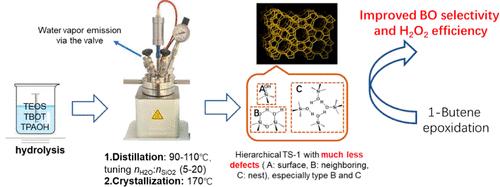当前位置:
X-MOL 学术
›
Ind. Eng. Chem. Res.
›
论文详情
Our official English website, www.x-mol.net, welcomes your feedback! (Note: you will need to create a separate account there.)
In Situ Tailoring the Crystalline Defects of Titanium Silicalite-1 (TS-1) to Improve the 1-Butene Epoxidation Performance
Industrial & Engineering Chemistry Research ( IF 3.8 ) Pub Date : 2024-06-28 , DOI: 10.1021/acs.iecr.4c01380 Tao Guo 1 , Baorong Wang 1, 2 , Chenlong Xue 1 , Xiaomeng Liu 1 , Chunhua Lin 1, 2 , Xianqing Xie 1 , Yibin Luo 3 , Weilin Liao 1 , Xingtian Shu 3
Industrial & Engineering Chemistry Research ( IF 3.8 ) Pub Date : 2024-06-28 , DOI: 10.1021/acs.iecr.4c01380 Tao Guo 1 , Baorong Wang 1, 2 , Chenlong Xue 1 , Xiaomeng Liu 1 , Chunhua Lin 1, 2 , Xianqing Xie 1 , Yibin Luo 3 , Weilin Liao 1 , Xingtian Shu 3
Affiliation

|
The crystalline defects are vitally important for the catalytic activity and stability of zeotype materials; however, the influences of which on the catalytic performance of TS-1 should further be studied. Herein, a modified hydrothermal synthesis process was developed to in situ tailor the framework defects of TS-1, and the physicochemical properties and catalytic performance were studied in detail. Generally, the nH2O/nSiO2 (5–20) of the precursor mixture was in situ tuned via distillation through the crystallization under 90–110 °C, and TS-1 with decreased framework defects can be directly synthesized during the following crystallization under 170 °C. When the nH2O/nSiO2 declined, the crystal size decreased; however, more intracrystalline mesopores (3.0–5.3 nm) can be introduced, the mesopore volume increased from 0.051 to 0.083 cm3/g. More importantly, the ratio of silicon species in Q4 (Si(OSi)4) to Q3 [Si(OSi)3(OH)] units increased from 29.9 to 55.0, and the hydroxyl groups in the nest or neighboring environments decreased more significantly than the surface silanol. Nevertheless, the titanium coordination states remained unchanged. Owing to the decreased framework defects, the weak acid sites declined from 191.5 to 160.5 μmol NH3/g, the epoxide selectivity in butene epoxidation reaction increased from 97.4 to 98.1%, while the H2O2 efficiency was enhanced from 96.7 to 98.6%. More importantly, the catalytic stability of TS-1 was also improved.
中文翻译:

原位修饰钛硅石-1 (TS-1) 的晶体缺陷以提高 1-丁烯环氧化性能
晶体缺陷对于类沸石材料的催化活性和稳定性至关重要;但其对TS-1催化性能的影响还有待进一步研究。在此,开发了一种改进的水热合成工艺来原位定制TS-1的骨架缺陷,并详细研究了其物理化学性质和催化性能。一般来说,前体混合物的 n H2O /n SiO2 (5-20) 通过在 90-110 °C 下结晶的蒸馏进行原位调节,TS-1 与减少的骨架缺陷可以在随后的170℃结晶过程中直接合成。当n H2O /n SiO2 下降时,晶体尺寸减小;然而,可以引入更多的晶内介孔(3.0-5.3 nm),介孔体积从0.051增加到0.083 cm 3 /g。更重要的是,Q4 (Si(OSi) 4 ) 与 Q3 [Si(OSi) 3 (OH)] 单元中硅物种的比率从 29.9 增加到 55.0,并且巢穴或邻近环境中的羟基比表面硅烷醇减少更显着。然而,钛的配位态保持不变。由于骨架缺陷减少,弱酸位由191.5 μmol NH 3 /g下降至160.5 μmol NH 3 /g,丁烯环氧化反应的环氧化物选择性由97.4%提高至98.1%,而H 2 效率从96.7%提高到98.6%。更重要的是,TS-1的催化稳定性也得到了提高。
更新日期:2024-06-28
中文翻译:

原位修饰钛硅石-1 (TS-1) 的晶体缺陷以提高 1-丁烯环氧化性能
晶体缺陷对于类沸石材料的催化活性和稳定性至关重要;但其对TS-1催化性能的影响还有待进一步研究。在此,开发了一种改进的水热合成工艺来原位定制TS-1的骨架缺陷,并详细研究了其物理化学性质和催化性能。一般来说,前体混合物的 n H2O /n SiO2 (5-20) 通过在 90-110 °C 下结晶的蒸馏进行原位调节,TS-1 与减少的骨架缺陷可以在随后的170℃结晶过程中直接合成。当n H2O /n SiO2 下降时,晶体尺寸减小;然而,可以引入更多的晶内介孔(3.0-5.3 nm),介孔体积从0.051增加到0.083 cm 3 /g。更重要的是,Q4 (Si(OSi) 4 ) 与 Q3 [Si(OSi) 3 (OH)] 单元中硅物种的比率从 29.9 增加到 55.0,并且巢穴或邻近环境中的羟基比表面硅烷醇减少更显着。然而,钛的配位态保持不变。由于骨架缺陷减少,弱酸位由191.5 μmol NH 3 /g下降至160.5 μmol NH 3 /g,丁烯环氧化反应的环氧化物选择性由97.4%提高至98.1%,而H 2 效率从96.7%提高到98.6%。更重要的是,TS-1的催化稳定性也得到了提高。











































 京公网安备 11010802027423号
京公网安备 11010802027423号